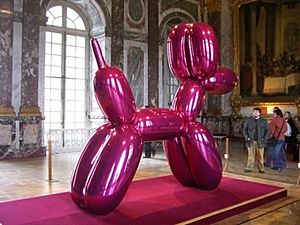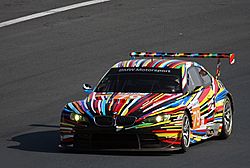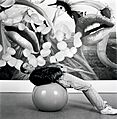Jeff Koons facts for kids
Quick facts for kids
Jeff Koons
|
|
|---|---|

Koons in 2014
|
|
| Born |
Jeffrey Lynn Koons
January 21, 1955 York, Pennsylvania, U.S.
|
| Education |
|
| Known for | Artist |
|
Notable work
|
|
| Spouse(s) |
Ilona Staller
(m. 1991–1994)
|
Jeffrey Lynn Koons (born January 21, 1955) is a famous American artist. He is known for creating art inspired by popular culture and everyday objects. His sculptures often look like balloon animals, but they are made from shiny stainless steel. Jeff Koons lives and works in New York City and his hometown of York, Pennsylvania. His artworks have sold for very high prices, setting records for living artists. For example, his Balloon Dog (Orange) sold for $58.4 million in 2013, and his Rabbit sold for $91.1 million in 2019.
Some people think Koons's art is groundbreaking and very important in art history. Others see it as simple or too focused on selling. Koons himself says his art doesn't have hidden meanings.
Contents
- Early Life and Art Journey
- How Jeff Koons Creates Art
- Early Artworks and Inflatables
- The "New" and "Equilibrium" Series
- The "Statuary" Series
- The "Luxury and Degradation" Series
- The "Banality" Series
- The "Celebration" Series
- The "Easyfun" and "Easyfun-Ethereal" Series
- The "Split-Rocker" Sculpture
- The "Popeye" and "Hulk Elvis" Series
- The "Antiquity" Series
- The "Gazing Ball" Series
- The "Apollo" Series
- Recent Art Projects
- Other Creative Works
- Exhibitions and Recognition
- Art Market and Sales
- Personal Life
- Images for kids
- See also
Early Life and Art Journey
Jeff Koons was born in York, Pennsylvania. His father sold furniture and decorated homes, and his mother was a seamstress. When he was nine, his father would display copies of old paintings that Jeff made in his shop window. As a child, he sold gift-wrapping paper and candy to earn money.
Art Education and Early Career
Koons studied painting at the Maryland Institute College of Art in Baltimore. He then went to the School of the Art Institute of Chicago from 1975 to 1976. In Chicago, he met artist Ed Paschke, who greatly influenced him. Koons even worked as Paschke's assistant.
After college, Koons moved to New York in 1977. He worked at the Museum of Modern Art while starting his art career. For a while, he dyed his hair red and wore a pencil mustache, like the famous artist Salvador Dalí. In 1980, he also worked as a stockbroker on Wall Street before focusing fully on his art.
How Jeff Koons Creates Art
After graduating in 1976, Koons moved to New York City. He started exploring art that looked at everyday objects, business, and society. He became well-known in the mid-1980s. His studio in New York was like a factory, with many assistants helping him create his art. This was similar to how Andy Warhol worked in his "Factory."
Koons uses a method called "art fabrication." This means his ideas are brought to life by skilled craftspeople. He uses technology to design his art on computers. To make sure everything looks consistent, he uses a "color-by-numbers" system. This way, his assistants can create his paintings and sculptures as if one person made them. Throughout his career, he has explored ideas like shopping, attraction, everyday things, and childhood.

Early Artworks and Inflatables
Jeff Koons began experimenting with everyday objects in his apartment in 1976. He was interested in fancy items and their cheaper versions. He collected toys, shiny metals, and porcelain. From 1977 to 1979, he made four artworks he called "Early Works." In 1978, he started his Inflatables series. These were inflatable flowers and a rabbit, placed with mirrors. Koons was inspired by how his father displayed furniture in his store.
The "New" and "Equilibrium" Series
Since 1979, Koons has created art in different series. His early works included "conceptual sculptures." For example, The Pre-New featured household items attached to lights. The New series showed vacuum cleaners, like the famous Hoover brand, displayed in lighted clear boxes. He first showed these at the New Museum in New York in 1980. The machines looked like they were in a showroom, with a sign saying "The New."
Another early series was The Equilibrium Series (1983). This included one to three basketballs floating in distilled water. Koons even worked with a Nobel Prize-winning physicist, Richard Feynman, to make the balls float perfectly. Some tanks were half-filled, making the balls float half in and half out of the water. This series also included posters of basketball stars and bronze objects that looked like lifesaving gear.
The "Statuary" Series
In 1986, Jeff Koons created the Statuary series. These ten pieces were new versions of his earlier inflatable works. The series showed how art can reflect how we see ourselves. Koons used everyday objects, like the inflatable rabbit, and turned them into shiny stainless-steel sculptures. This led to one of his most famous works, Rabbit (1986).
There are three identical versions of Rabbit. One is at the Museum of Contemporary Art, Chicago, and another at The Broad Museum in Los Angeles. In 2019, one version of Rabbit sold for $91,075,000 at Christie's Auction House. This set a new record for the most expensive artwork sold by a living artist.
A giant, soft version of the Rabbit, over 50 feet tall, was part of the Macy's Thanksgiving day parade in 2007. It was later displayed in Toronto in 2009. Other objects in the series mixed souvenirs with older art styles, playing with the idea of "low art" versus "high art."
The "Luxury and Degradation" Series
The Luxury and Degradation series, first shown in 1986, focused on alcohol. This group included a shiny stainless steel travel cocktail cabinet and other handmade items related to drinks. It also featured framed advertisements for drinks like Gordon's Gin and Hennessy. Koons took these ads and made them into art, giving them new meaning.
One artwork, Jim Beam – J.B. Turner Engine (1986), was based on a collectible train bottle from Jim Beam. Koons had it cast in gleaming stainless steel. Another piece, Jim Beam – Baggage Car (1986), even contained Jim Beam bourbon. Koons used these works to explore ideas of luxury and how things can appear fancy but be "fake."
The same shiny stainless steel was used for the statue of Kiepenkerl. In 1987, Koons replaced an old statue in Münster, Germany, with his new version for an art exhibition. This statue, which looked like a traveling merchant, kept its cultural importance.
The "Banality" Series
Koons then created the Banality series. For this, he worked with workshops in Germany and Italy known for ceramics, porcelain, and wood. This series included Michael Jackson and Bubbles (1988). This was a life-size, gold-leaf plated porcelain statue of the singer with his pet chimpanzee. One of these sold for $5.6 million. Two are now in museums in San Francisco and Los Angeles.
Koons also created advertisements for his own art shows. He wanted to control how people saw his work. He even hired an image consultant and gave interviews where he talked about himself in the third person.
The "Celebration" Series
Koons's Celebration series was inspired by his desire for his son Ludwig to return home. This series, started in 1994, includes large sculptures and paintings of balloon dogs, Valentine hearts, diamonds, and Easter eggs. Some pieces are still being made. Each of the 20 sculptures comes in five different colors. His Egg (Blue) won an award in 2008. The Diamond pieces, made of shiny stainless steel, are seven feet wide.
His work Tulips (1995–2004) is a huge bouquet of colorful balloon flowers, over 2 meters (6.5 feet) tall and 5 meters (16 feet) wide. Koons started working on Balloon Flower in 1995.
The Celebration series was very expensive to make. Koons got help from art collectors and dealers to fund the creation of these costly sculptures, including his Balloon Dog and Moon series.
In 2006, Koons showed Hanging Heart, a 9-foot-tall polished steel heart. This was one of five different colored hearts in the Celebration series. Later additions include Balloon Swan (2004–2011), Balloon Rabbit (2005–2010), and Balloon Monkey. These take simple party favors and turn them into huge, amazing art pieces. The series also includes sixteen oil paintings.
The "Easyfun" and "Easyfun-Ethereal" Series
In 1999, Koons created the first seven paintings for his Easyfun series. These included paintings and sculptures for walls. In 2001, he started the Easyfun-Ethereal paintings. These used a collage style, combining images of bikinis, food, and landscapes. His assistants painted these under his guidance. This series eventually grew to twenty-four paintings.
The "Split-Rocker" Sculpture
In 2000, Koons designed Split-Rocker, another large floral sculpture. It's made of stainless steel, soil, and has an internal watering system. It was first shown in France. Like Puppy, it's covered with about 27,000 live flowers. Weighing 150 tons and standing over 37 feet tall, Split-Rocker is made of two halves. One half is based on a toy pony, and the other on a toy dinosaur. Together, they form the head of a giant child's rocking toy. In 2014, Split-Rocker was displayed at Rockefeller Center in New York City.
The "Popeye" and "Hulk Elvis" Series
The Popeye series, which Koons began in 2002, features the cartoon characters Popeye and Olive Oyl. One piece is a stainless steel copy of a plastic Popeye figurine. The artist also used inflatable animals again, combining them with ladders, trashcans, and fences. To make these sculptures, the toys are coated, then a hard copy is made and cast in aluminum. Finally, they are painted to look shiny like the original inflatables.
Hulk Elvis is a series of works Koons created between 2004 and 2014. It includes bronze sculptures and large oil paintings. The title combines the comic book hero Hulk with the pop icon Elvis Presley. The multiple images of the Hulk are similar to Andy Warhol's Triple Elvis.
Koons says the Hulk Elvis series is "very high-energy." He also sees it as a "bridge between East and West," comparing the Hulk to Asian guardian gods. The sculptures in this series, like Hulk (Friends) and Hulks (Bell), look inflatable but are made of heavy bronze and wood. Hulk (Organ) (2004–2014) even includes a working musical instrument.
The paintings in this series are like collages made with computer layers. They show abstract landscapes, American symbols like trains and horses, and characters like the Hulk.
The "Antiquity" Series
In 2008, Jeff Koons started his Antiquity series. This series explores how eros, fertility, and beauty have been shown in art throughout history. Each painting in the Antiquity series (2009–2013) features a famous ancient sculpture, painted in great detail. The backgrounds often show beautiful, natural scenes. Koons uses modern technology, like CT scans and digital imaging, to create his metal sculptures. He reinterprets old figures by making them into balloon-like sculptures, such as the Metallic Venus, and by adding comic book characters.
Metallic Venus (2010–2012) was made of shiny stainless steel with a clear color coating and live flowers. Ballerinas (2010–2014) shows dancer figurines, based on porcelain works by Ukrainian artist Oksana Zhnikrup, but made as large as classical sculptures.
The "Gazing Ball" Series
In this series, shown in 2015, Koons took 35 famous paintings, like Manet's Déjeuner sur l'Herbe and Rembrandt's Self-Portrait. He had them repainted and added a small shelf to each. On this shelf sits a blue glass gazing ball. Both the viewer and the painting are reflected in the ball.
The series is named after the mirrored balls often found in gardens, like those around Koons's childhood home. After the paintings, Koons also made white sculptures from the Greco-Roman era, along with everyday objects like mailboxes and birdbaths, all with gazing balls.
The "Apollo" Series
In June 2022, Koons created the Apollo series for an art space on the Greek island of Hydra. This included a sculpture called Apollo Wind Spinner (2020–2022), a 9.1-meter (30-foot) wide reflective spinner. The walls of the art space were decorated with ancient frescoes from Boscoreale. The exhibition also featured bronze Nike sneakers and other new works.
Recent Art Projects
For the 2007–2008 season at the Vienna State Opera, Koons designed a huge picture (176 square meters) called Geisha. Koons also worked with pop star Lady Gaga on her 2013 album Artpop, creating the cover artwork which featured a sculpture he made of her.
In September 2014, GARAGE Magazine published Koons's first digital artwork, Lady Bug. This was an augmented reality sculpture that could only be seen on mobile devices through an app.
In 2012, Koons bought a high-tech stone workshop. This facility now only creates his stone artworks. In 2013, Koons created the sculpture Gazing Ball (Farnese Hercules), inspired by the Farnese Hercules.
Other Creative Works
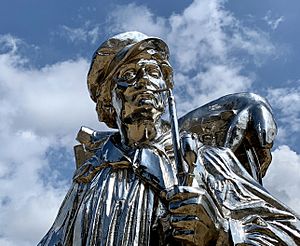
A drawing similar to his Tulip Balloons appeared on the front page of Google on April 30 and May 1, 2008.
In 2006, Koons appeared on Artstar, a TV show about the New York art world. He also had a small role in the 2008 movie Milk.
In 2019, Koons unveiled Bouquet of Tulips, an 11-meter (36-foot) high sculpture in Paris. It was inspired by the Statue of Liberty and honored the victims of the November 2015 attacks.
In February 2024, a SpaceX rocket carried 125 of Koons's miniature stainless steel moon sculptures into space. These sculptures, named after historical figures, were part of a project to place the first authorized artwork on the Moon. Koons was inspired by President Kennedy's vision of space exploration.
Art Curation
Koons has also helped organize art exhibitions. In 2009, he curated an Ed Paschke exhibition in New York. In 2010, he curated an exhibition of works from a private collection at the New Museum in New York City.
BMW Art Car
Koons was chosen to design the seventeenth BMW Art Car. His artwork was put on a BMW M3 race car. It was shown in Paris in June 2010 and then competed in the 2010 24 Hours of Le Mans race in France.
Art Collaborations
In 2013, Koons worked with American singer Lady Gaga for her album ARTPOP. The album cover shows a sculpture Koons made of Lady Gaga behind a blue ball sculpture. The song "Applause" even has the lyrics "One second I'm a Koons, then suddenly the Koons is me."
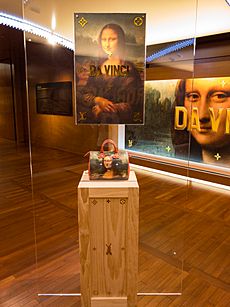
In April 2017, Koons collaborated with the French luxury fashion brand Louis Vuitton. He designed a series of handbags and backpacks featuring copies of famous paintings by Old Masters like Leonardo da Vinci and Vincent van Gogh. Later that year, he presented more bags with works by Claude Monet and Paul Gauguin.
Wine Labels
Koons has also designed labels for fine wine. In 2012, Chateau Mouton Rothschild announced that Koons designed their 2010 vintage label. Other famous artists like Pablo Picasso and Salvador Dalí have also designed labels for them. In 2013, Dom Pérignon released a special edition of their 2004 vintage with a design by Koons.
Charity Work
Koons is a member of the board of directors for the International Centre for Missing & Exploited Children (ICMEC). This organization works to protect children. In 2007, Koons and his wife Justine started the ICMEC Koons Family Institute on International Law and Policy. Koons has given over $4.3 million to this Institute.
Exhibitions and Recognition
Since 1980, Koons's art has been shown in many places around the world. His Made in Heaven series was first shown at the Venice Biennale in 1990.
His art has been part of many important exhibitions. In 1997, he had his first solo show in Europe in Paris. His museum solo shows include the Museum of Contemporary Art, Chicago (1988), Walker Art Center in Minneapolis (1993), and the Deutsche Guggenheim in Berlin (2000).
In 2008, 17 of Koons's sculptures were shown at the Château de Versailles in France. This was the first time a major American contemporary artist had such a large display there. The exhibition was very popular and broke attendance records at the Museum of Contemporary Art, Chicago in 2008.
In July 2009, Koons had his first big solo show in London, featuring his Popeye Series. In 2012, he had a major show in Switzerland, displaying works from his The New, Banality, and Celebration series, as well as Split-Rocker.
A large exhibition of his work was held at the Whitney Museum of American Art in New York in 2014. In 2019, an exhibition called Jeff Koons at the Ashmolean was held in Oxford, United Kingdom.
Awards and Honors
Koons has received many awards for his art. He received the BZ Cultural Award in 2000 and the Skowhegan Medal for Sculpture in 2001. He was made a Chevalier of the French Legion of Honor in 2002 and promoted to Officier in 2007. He received an honorary doctorate from the School of the Art Institute of Chicago in 2008. In 2013, he received the U.S. State Department's Medal of Arts. In 2014, he received the Golden Plate Award from the American Academy of Achievement. In 2017, he received an Honorary Membership Award from the Edgar Wind Society at the University of Oxford. In 2019, he was made an Honorary Professor of Sculpture in Italy.
Art Market and Sales
Many art collectors in America and Europe own Koons's work. Some collectors, like Eli Broad and Dakis Joannou, own many pieces from different stages of his career.
Koons's art has been sold by well-known art dealers like Sonnabend Gallery and Gagosian Gallery. Since 2021, Pace Gallery has been his main representative worldwide.
His sculptures, especially those from his Celebration series, have achieved very high prices at auctions. In 2001, one of his Michael Jackson and Bubbles sculptures sold for $5.6 million. In 2007, Hanging Heart (Magenta/Gold) sold for $23.6 million, becoming the most expensive piece by a living artist at auction at that time. In 2008, his Balloon Flower (Magenta) sold for $25.7 million.
In 2012, Tulips (1995–2004) set a new auction record for Koons, selling for $33.6 million. In 2019, Koons's stainless steel Rabbit (1986) sold for $91.1 million at auction. This made it the most expensive work sold by a living artist at auction.
Artists sometimes face legal challenges when they use existing images in their work. Koons has been involved in some of these cases.
Personal Life
Jeff Koons has a daughter named Shannon Rodgers from a previous relationship. She was adopted, and they reconnected in 1995. Koons said that the adoption made him want to be more visible so his daughter could find him.
In 1991, he married Ilona Staller. They had a son in 1992. Koons later married Justine Wheeler, who is also an artist and used to work in his studio. As of June 2009, they have four children together.
Images for kids
-
Three Ball Total Equilibrium Tank (1983) by Koons at Tate Liverpool
-
Puppy (head detail) Guggenheim Museum Bilbao, Spain
-
Kiepenkerl, located in the Hirshhorn Museum and Sculpture Garden in Washington, D.C.
-
Louis Vuitton Da Vinci bag
See also
 In Spanish: Jeff Koons para niños
In Spanish: Jeff Koons para niños


